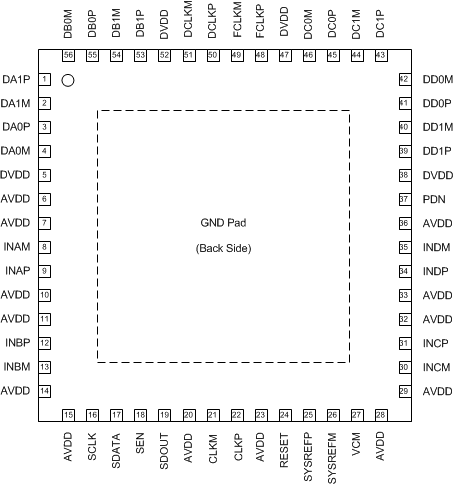SBAS673A July 2014 – October 2015 ADC3421 , ADC3422 , ADC3423 , ADC3424
PRODUCTION DATA.
- 1 Features
- 2 Applications
- 3 Description
- 4 Revision History
- 5 Device Comparison Table
- 6 Pin Configuration and Functions
-
7 Specifications
- 7.1 Absolute Maximum Ratings
- 7.2 ESD Ratings
- 7.3 Recommended Operating Conditions
- 7.4 Thermal Information
- 7.5 Electrical Characteristics: General
- 7.6 Electrical Characteristics: ADC3421, ADC3422
- 7.7 Electrical Characteristics: ADC3423, ADC3424
- 7.8 AC Performance: ADC3421
- 7.9 AC Performance: ADC3422
- 7.10 AC Performance: ADC3423
- 7.11 AC Performance: ADC3424
- 7.12 Digital Characteristics
- 7.13 Timing Requirements: General
- 7.14 Timing Requirements: LVDS Output
- 7.15 Typical Characteristics: ADC3421
- 7.16 Typical Characteristics: ADC3422
- 7.17 Typical Characteristics: ADC3423
- 7.18 Typical Characteristics: ADC3424
- 7.19 Typical Characteristics: Common
- 7.20 Typical Characteristics: Contour
- 8 Parameter Measurement Information
-
9 Detailed Description
- 9.1 Overview
- 9.2 Functional Block Diagram
- 9.3 Feature Description
- 9.4 Device Functional Modes
- 9.5 Programming
- 9.6
Register Maps
- 9.6.1
Serial Register Description
- 9.6.1.1 Register 13h (address = 13h)
- 9.6.1.2 Register 11Dh (address = 11Dh)
- 9.6.1.3 Register 21Dh (address = 21Dh)
- 9.6.1.4 Register 308h (address = 308h)
- 9.6.1.5 Register 41Dh (address = 41Dh)
- 9.6.1.6 Register 51Dh (address = 51Dh)
- 9.6.1.7 Register 608h (address = 608h)
- 9.6.1.8 Register 70Ah (address = 70Ah)
- 9.6.1
Serial Register Description
- 10Applications and Implementation
- 11Power Supply Recommendations
- 12Layout
- 13Device and Documentation Support
- 14Mechanical, Packaging, and Orderable Information
パッケージ・オプション
メカニカル・データ(パッケージ|ピン)
- RTQ|56
サーマルパッド・メカニカル・データ
- RTQ|56
発注情報
6 Pin Configuration and Functions
RTQ Package
VQFN-56
Top View

Pin Functions
| PIN | I/O | DESCRIPTION | |
|---|---|---|---|
| NAME | NO. | ||
| AVDD | 6, 7, 10, 11, 14, 15, 20, 23, 28, 29, 32, 33, 36 | I | Analog 1.8-V power supply |
| CLKM | 21 | I | Negative differential clock input for the ADC |
| CLKP | 22 | I | Positive differential clock input for the ADC |
| DA0M | 4 | O | Negative serial LVDS output for wire-0 of channel A |
| DA0P | 3 | O | Positive serial LVDS output for wire-0 of channel A |
| DA1M | 2 | O | Negative serial LVDS output for wire-1 of channel A |
| DA1P | 1 | O | Positive serial LVDS output for wire-1 of channel A |
| DB0M | 56 | O | Negative serial LVDS output for wire-0 of channel B |
| DB0P | 55 | O | Positive serial LVDS output for wire-0 of channel B |
| DB1M | 54 | O | Negative serial LVDS output for wire-1 of channel B |
| DB1P | 53 | O | Positive serial LVDS output for wire-1 of channel B |
| DC0M | 46 | O | Negative serial LVDS output for wire-0 of channel C |
| DC0P | 45 | O | Positive serial LVDS output for wire-0 of channel C |
| DC1M | 44 | O | Negative serial LVDS output for wire-1 of channel C |
| DC1P | 43 | O | Positive serial LVDS output for wire-1 of channel C |
| DD0M | 42 | O | Negative serial LVDS output for wire-0 of channel D |
| DD0P | 41 | O | Positive serial LVDS output for wire-0 of channel D |
| DD1M | 40 | O | Negative serial LVDS output for wire-1 of channel D |
| DD1P | 39 | O | Positive serial LVDS output for wire-1 of channel D |
| DCLKM | 51 | O | Negative bit clock output |
| DCLKP | 50 | O | Positive bit clock output |
| DVDD | 5, 38, 47, 52 | I | Digital 1.8-V power supply |
| FCLKM | 49 | O | Negative frame clock output |
| FCLKP | 48 | O | Positive frame clock output |
| GND | PowerPAD™ | I | Ground, 0 V |
| INAM | 8 | I | Negative differential analog input for channel A |
| INAP | 9 | I | Positive differential analog input for channel A |
| INBM | 13 | I | Negative differential analog input for channel B |
| INBP | 12 | I | Positive differential analog input for channel B |
| INCM | 30 | I | Negative differential analog input for channel C |
| INCP | 31 | I | Positive differential analog input for channel C |
| INDM | 35 | I | Negative differential analog input for channel D |
| INDP | 34 | I | Positive differential analog input for channel D |
| PDN | 37 | I | Power-down control. This pin can be configured via the SPI. This pin has an internal 150-kΩ pulldown resistor. |
| RESET | 24 | I | Hardware reset; active high. This pin has an internal 150-kΩ pulldown resistor. |
| SCLK | 16 | I | Serial interface clock input. This pin has an internal 150-kΩ pulldown resistor. |
| SDATA | 17 | I | Serial interface data input. This pin has an internal 150-kΩ pulldown resistor. |
| SDOUT | 19 | O | Serial interface data output |
| SEN | 18 | I | Serial interface enable; active low. This pin has an internal 150-kΩ pullup resistor to AVDD. |
| SYSREFM | 26 | I | Negative external SYSREF input |
| SYSREFP | 25 | I | Positive external SYSREF input |
| VCM | 27 | O | Common-mode voltage for analog inputs |